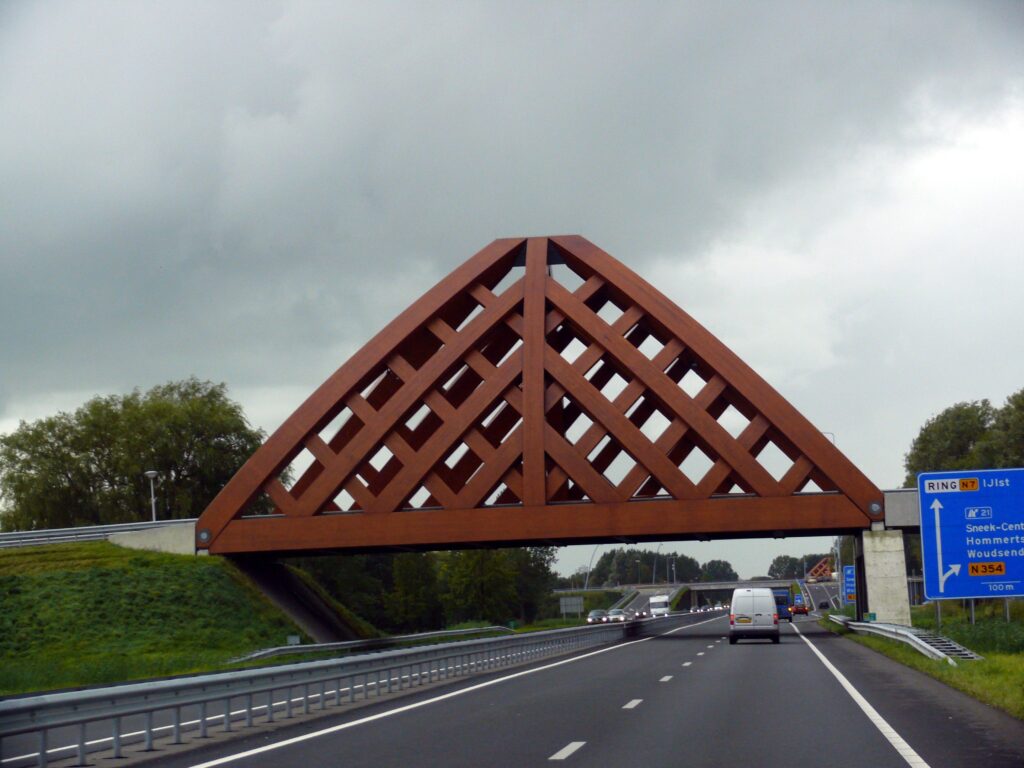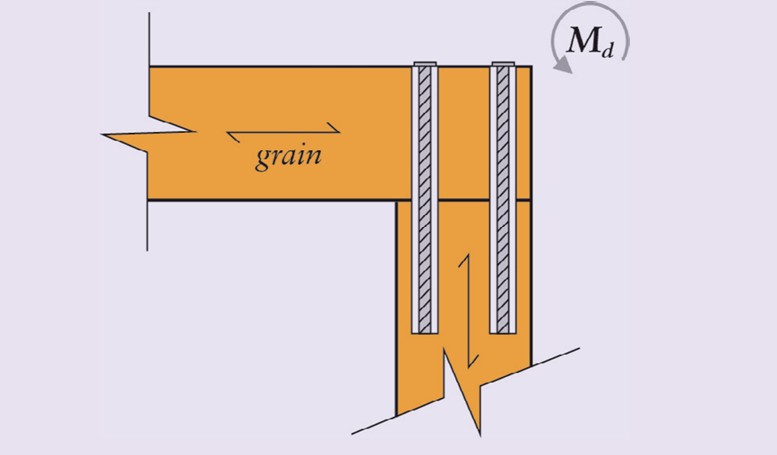This article explores into the principles, design considerations, and practical implementation of glued-in rod connections.

Timber construction has evolved significantly, with innovations like glued-in rods enabling stronger, more versatile timber connections. Glued-in rods provide concealed connections capable of transferring large forces with minimal slip, making them invaluable in modern timber engineering. These connections are often used in structures incorporating glued laminated timber (glulam) or laminated veneer lumber (LVL), which have high mechanical properties and near-unlimited size potential. As a result, glued-in rods address the increasing demand for robust, aesthetically discreet timber connections.
This article explores into the principles, design considerations, and practical implementation of glued-in rod connections, culminating in a comprehensive worked example.
Glued-in Rods
Glued-in rods are engineered timber connections where steel or fiber-reinforced polymer (FRP) rods are embedded into pre-drilled holes within a timber member and bonded with adhesive. This system is particularly effective in transferring axial forces, shear forces, and moments, making it ideal for a wide range of structural applications, including moment-resisting portal frames, trusses, and beam-to-column connections.
The development of glued-in rod technology represents a significant leap from traditional timber connectors, such as bolts, nails, or dowels, which often introduce stress concentrations and require larger connection zones. In contrast, glued-in rods ensure a more uniform stress distribution and preserve the aesthetics and structural integrity of the timber. They are especially advantageous in applications where compact connections are required, or where architectural demands call for hidden fastening solutions.
Advantages of Glued-in Rod Connections
The widespread adoption of glued-in rod connections stems from their distinct advantages over conventional connection methods:
High Load-Carrying Capacity: Glued-in rod connections exhibit exceptional strength, allowing them to handle large axial and bending forces. The adhesive bond ensures full utilization of the rod’s capacity, unlike traditional fasteners, where slip and deformation are common.
High Stiffness: One of the standout features of glued-in rods is their ability to achieve extremely high stiffness. A well-designed glued-in rod connection, using epoxy adhesive with a 2 mm bond line thickness, can attain a stiffness exceeding 150 kN/mm. This high stiffness minimizes deformation, making glued-in rods particularly suitable for applications requiring precise load transfer and minimal joint movement.
Compact and Aesthetic Design: Since the rods are fully embedded in the timber, glued-in rod connections create a clean and concealed joint. This feature is especially important in exposed timber structures where aesthetics are a priority.
Improved Durability: The adhesive used in glued-in rod connections acts as a protective layer, preventing moisture ingress and reducing the risk of corrosion or decay around the joint.
Versatility: Glued-in rods can be used with a variety of adhesives and rod materials, making them adaptable to diverse design requirements. Adhesive types such as epoxy, polyurethane, or phenol-resorcinol-formaldehyde (PRF) can be selected based on factors like load duration, environmental exposure, and bonding strength.
Key Design Considerations
The design of glued-in rod connections must balance structural efficiency, safety, and durability. The following aspects are critical in achieving a reliable and functional connection:
1. Tensile Capacity of Rods
The tensile capacity of the embedded rods is a primary consideration in the design. The tensile force (Ft,rod) is calculated as:
F_{t,rod}=A_s\times f_ywhere:
- As is the Effective cross-sectional area of the rod,
- fy is the Yield strength of the rod material.
Steel rods with higher grades (e.g., 8.8 or 10.9) can increase the connection’s capacity, but this must be matched by the adhesive and timber properties.
2. Bond Strength Between Adhesive and Timber
The adhesive bond strength depends on factors such as timber density (ρk), adhesive type, and embedment length (l). Eurocode 5 provides guidelines for short and long embedment lengths:
For l<200 mm
f_{bond}=f_{short}\times k_{mod}\times \rho_kFor l≥200 mm
f_{bond}=f_{long}\times k_{mod}\times \rho_kHere, fshort and flong are bond strength factors specific to the adhesive used, and kmod accounts for service class and load duration.
3. Embedment Length
The embedment length (lll) of the rod plays a crucial role in ensuring sufficient bond strength. A longer embedment length increases the connection’s capacity but may also introduce stress concentrations at the rod ends. To determine the required embedment length:
l=\frac{F_{t,rod}}{n\times f_{bond}\times d_{ef}}where:
- n: Number of rods,
- def: Effective diameter of the rod (often limited by the hole diameter or adhesive bondline).
4. Timber Strength
The timber behind the rods must resist the stresses induced by axial forces. These stresses include compression or tension parallel to the grain and compression perpendicular to the grain:
- Axial stresses: ft or fc
- Compression perpendicular to the grain: fc,90
The timber’s characteristic strength values are reduced by safety factors (γm) and modification factors (kmod) to account for variability in material properties and environmental effects.
5. Stiffness of the Connection
The adhesive’s modulus of elasticity, rod material, timber modulus, and embedment geometry influence the stiffness of a glued-in rod connection. Calculate the effective bending stiffness (EI) as:
(EI)_{eff}=E_{glulam}\times [\frac{bh^3}{12}+nA_s(x-d_r)^2]where:
- x is Neutral axis location,
- dr is Distance from the centroid of the rod to the neutral axis.
High stiffness is essential in moment-resisting applications where joint flexibility could compromise structural performance.
Worked Example
Design a moment-resisting glued-in rod connection for a portal frame subjected to a bending moment of 18.0 kNm. The connection employs M12 threaded steel rods bonded with epoxy resin into GL30h softwood glulam. Key parameters for the glulam include a breadth of 140 mm, depth of 360 mm, characteristic density of 430 kg/m³, bending strength of 30 N/mm², and compression strength perpendicular to the grain of 2.5 N/mm². For the rods, the diameter is 12 mm, the effective area is 113 mm², and the yield strength is 240 N/mm². The epoxy adhesive used has a bond strength factor (flong = 0.520.

Step 1: Bond Strength and Embedment Length
Calculate bond strength:
f_{bond}=f_{long}\times k_{mod}\times \rho_k\\=0.520\times0.80\times430=179.2N/mm^2Calculate embedment length:
l=\frac{F_{t,rod}}{nF_{bond}d_{ef}}For Ft,rod=27120N and n=2 rods:
l=\frac{27120}{2\times179.2\times15}=505.5mmUse l=170mm for safety.
Step 2: Timber and Rod Stresses
Bending Stress:
\sigma_m= \frac{M_d}{\frac{1}{6}bh^2}=\frac{18000}{\frac{1}{6}\times140\times360^2} =5.93N/mm^2\sigma_m < \frac{f_{m,k}}{\gamma_{m}}=\frac{30}{1.25}=24N/mm^2Compression Perpendicular to Grain:
\sigma_{c,0}=\frac{F_{rod}}{bd_e}=\frac{27120}{140\times40}=4.85N/mm^2\sigma_{c,0}< \frac{f_{c,90,k}}{\gamma_{m}}=\frac{2}{1.25}=1.6N/mm^2Step 3: Moment Capacity
M_{max}=\frac{nf_yA_sh'}{\gamma_m}Where h’ = h/2 = 360/2 = 180mm
M_{max}=\frac{4\times240\times113\times180}{1.25}=15.6kN.mConclusion
Glued-in rod connections represent a state-of-the-art solution for timber joints, offering exceptional strength, stiffness, and aesthetic appeal. However, their design requires meticulous attention to detail, especially regarding bond strength, timber capacity, and rod embedment length. This article’s worked example illustrates the step-by-step design process, highlighting the challenges and opportunities in achieving safe and efficient connections.
Also See: Design of Timber Connections to Eurocode 5: A Comprehensive Guide with Worked Example
Sources & Citations
BS EN 1995-1-1:2004: Eurocode 5 – Design of Timber Structures: General, Common Rules, and Rules for Buildings. European Committee for Standardization (CEN), Brussels.
BS EN ISO 898-1:2013: Mechanical Properties of Fasteners Made of Carbon Steel and Alloy Steel – Part 1: Bolts, Screws and Studs with Specified Property Classes. British Standards Institution (BSI), London.
Manual for the Design of Timber Building Structures to Eurocode 5 (Section 6.8). Institution of Structural Engineers (IStructE), London.